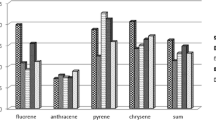Abstract
This paper presents transformations of saturated hydrocarbons of petroleum type pollutants during ex situ bioremediation of soil on the pilot heap (halde), during a period of 6 months, within the grounds of Petroleum Refinery Pančevo (Serbia). Samples for analysis were taken in time intervals of 2 weeks (P1–P12 samples). Organic substance was extracted by Soxhlet’s method and quantified. Isoprenoid aliphatics, in particular pristane and phytane, and polycyclic aliphatics of sterane and triterpane types in saturated hydrocarbon fractions were analysed by GC-MS (SIM method). Significant amounts of n-alkanes have not been detected. The MS-chromatogram revealed only marginal amounts of pristane and phytane in sample P1. Pristane and phytane occurred in sample P8, and in even higher quantities in the final sample P12. The proceeding bioremediation process was accompanied by the decrease of the relative amounts of pentacyclic terpanes of hopane type, compared to tri- and tetracyclic terpanes. In the initial sample P1 the distribution of steranes and hopanes follows a pattern, which is characteristic for crude oils. However, their identification by SIM method was not possible in samples P8 and P12 because of the reduced concentration. The observed changes in the alkane fractions’ compositions may be considered as atypical, referring to the fact that during oil biodegradation under natural conditions, decomposition of isoprenoids occurs much easier and faster than decomposition of polycyclic alkanes of tri-, tetra- and pentacyclic terpane, sterane and diasterane types, after the decomposition of n-alkanes has been almost completed.





Similar content being viewed by others
References
Antić, M., Jovančićević, B., Ilić, M., Vrvić, M., & Schwarzbauer, J. (2006). Petroleum pollutant degradation by surface water microorganisms. Environmental Science & Pollution Research, 13, 320–327.
Campanella, B., Bock, C., & Schröder, P. (2002). Phytoremediation to increase the degradation of PCBs and PCDD/Fs: Potential and limitations. Environmental Science & Pollution Research, 9, 73–85.
Guerin, T. F. (2000). The differential removal of aged polycyclic aromatic hydrocarbons from soil during bioremediation. Environmental Science & Pollution Research, 7, 19–26.
Haddox, D., & Cutright, T. (2003). Evaluation of two bacterial delivery systems for in-situ remediation of PAH contaminated sediments. Journal of Soils and Sediments, 3, 41–48.
Hurst, C. J., Crawford, R. L., Knudsen, R., McInerney, M. J., & Stetzenbach, L. D. (2002). Manual of environmental microbiology, 2nd Ed. Washington: ASM Press.
Iqbal, J., Metosh-Dickey, C., & Portier, R. (2007). Temperature effects on bioremediation of PAHs and PCP contaminated South Louisiana soils: A laboratory mesocosm study. Journal of Soils and Sediments, 7, 153–158.
Isikhuemhen, O., Anoliefo, G., & Oghale, O. (2003). Bioremediation of crude oil polluted soil by the white rot fungus, Pleurotus tuberregium (Fr.) sing. Environmental Science & Pollution Research, 10, 108–112.
Jovančićević, B., Tasić, L., Wehner, H., Faber, E., Šušić, N., & Polić, P. (1997). Identification of oil-type pollution in recent sediments. Fresenius Environmental Bulletin, 6, 667–673.
Jovančićević, B., Polić, P., Vrvić, M., Sheeder, G., Teschner, T., & Wehner, H. (2003). Transformations of n-alkanes from petroleum pollutants in alluvial ground waters. Environmental Chemistry Letters, 1, 73–81.
Jovančićević, B., Antić, M., Šolević, T., Vrvić, M., Kronimus, A., & Schwarzbauer, J. (2005). Investigation of interactions between surface water and petroleum type pollutant. Environmental Science & Pollution Research, 12, 205–212.
Jovančićević, B., Vrvić, M., Schwarzbauer, J., Wehner, H., Scheeder, G., & Vitorović, D. (2007). Organic-geochemical differentiation of petroleum-type pollutants and study of their fate in Danube alluvial sediments and corresponding water (Pančevo Oil Refinery, Serbia). Water, Air and Soil Pollution, 183, 225–238.
Peters, K. E., Walters, C. C., & Moldowan, J. M. (2005). The biomarker guide. Cambridge: Cambridge University Press.
Reed, W. E. (1977). Molecular composition of weathered petroleum and comparison with its possible source. Geochimica et Cosmochimica Acta, 41, 237–247.
Rosa, A. P., Trigüis, J. A. (2007). Bioremediation process on Brazil shoreline. Laboratory experiments. Environmental Science & Pollution Research, 14, 470–476.
Saponaro, S., & Bonomo, L. (2003). Influence of environmental factors on the biological treatment of organic compounds in contaminated Lagoon sediments. Journal of Soils and Sediments, 3, 165–172.
Seifert, W. K., & Moldowan, J. M. (1979). The effect of biodegradation of steranes and terpanes in crude oils. Geochimica et Cosmochimica Acta, 43, 111–126.
Seifert, W. K., Moldowan, J. M., & Demaison, G. J. (1984). Source correlation of biodegraded oils. Organic Geochemistry, 6, 633–643.
Stojanović, K., Jovančićević, B., Pevneva, G. S., Golovko, J. A., Golovko, A. K., & Pfendt, P. (2001). Maturity assessment of oils from the Sakhalin oil fields in Russia: phenanthrene content as a tool. Organic Geochemistry, 32, 721–731.
Tissot, B. P., & Welte, D. H. (1984). Petroleum formation and occurrence. Berlin: Springer.
Volkman, J. K., Alexander, R., Kagi, R. I., & Woodhouse, G. W. (1983). Demethylated hopanes in crude oils and their applications in petroleum geochemistry. Geochimica Cosmochimica Acta, 47, 785–794.
Acknowledgments
We thank the Alexander von Humboldt Foundation and the Ministry of Science and Environment Protection of the Republic of Serbia for supporting this research.
Author information
Authors and Affiliations
Corresponding author
Rights and permissions
About this article
Cite this article
Jovančićević, B., Antić, M., Pavlović, I. et al. Transformation of Petroleum Saturated Hydrocarbons during Soil Bioremediation Experiments. Water Air Soil Pollut 190, 299–307 (2008). https://doi.org/10.1007/s11270-007-9601-z
Received:
Accepted:
Published:
Issue Date:
DOI: https://doi.org/10.1007/s11270-007-9601-z



